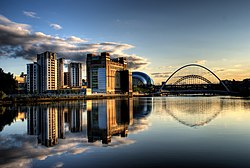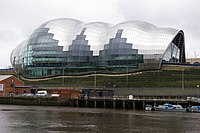Gateshead
| Gateshead | |
| County Durham | |
|---|---|
 Gateshead Waterfront | |
| Location | |
| Grid reference: | NZ2460 |
| Location: | 54°57’0"N, 1°36’0"W |
| Data | |
| Population: | 78,403 (2001) |
| Post town: | Gateshead |
| Postcode: | NE8-NE11 |
| Dialling code: | 0191 |
| Local Government | |
| Council: | Gateshead |
| Parliamentary constituency: |
Gateshead |
Gateshead is a town in County Durham. It lies on the southern bank of the River Tyne opposite Newcastle upon Tyne and together they form the urban core of the "Tyneside" conurbation. Gateshead town centre and Newcastle City Centre are joined by seven different bridges across the Tyne, including the landmark Gateshead Millennium Bridge. The town is becoming increasingly well known for several examples of iconic architecture such as The Sage Gateshead, the Angel of the North and the Baltic Centre for Contemporary Art.
Contents
The town
One of the most distinguishing features of Gateshead is its dramatic topography. The land rises 230 feet from Gateshead Quays to the town centre and continues rising to a height of 525 feet at Queen Elizabeth Hospital in Sheriff Hill.[1] The town's hills stand in contrast to the flat and low lying Team Valley located on the western edges of town. The high elevations allow for impressive views over the Tyne valley into Newcastle and across to Sunderland and the North Sea from lookouts in Windmill Hills and Windy Nook respectively [2][3]
Given the proximity of Gateshead to Newcastle, just south of the River Tyne from the city centre, it is sometimes looked upon as part of Newcastle. The to towns' respective local councils teamed up in 2000 to create a unified marketing brand name, "NewcastleGateshead", better to promote the Tyneside conurbation.
Name of the town
The origin of the name 'Gateshead' is subject to various theories. Some say it means 'head of the road' ("gate" being a Norse and Northern word for "street", the town lying at the bridgehead of a Roman road) and others suggest "goat’s headland", as the River Tyne at this point was once roamed by goats.
In Old English the town was named Rægeheafod from ræge, meaning a young, wild she-goat. In Bede's Ecclesiatical History of the English and its later Englisc translation he refers to a minster ad Caprae caput or æt Hrege heafde meaning "Goat's Head", which suggests that the "goat's head" theory is correct.
History
There has been a settlement on the Gateshead side of the River Tyne, around the old river crossing where the Swing Bridge now stands, since Roman times.
The first recorded mention of Gateshead is in the writings of the Venerable Bede who referred to an Abbot of Gateshead called Utta in 623.
In 1068 William the Conqueror defeated the forces of Edgar the Ætheling and his brother in law Malcolm III King of Scotland on Gateshead Fell (now Low Fell). In 1080, Walcher, Bishop of Durham and Earl of Northumbria, was murdered by a mob at Gateshead. He had called a meeting here to resolve differences between his men and the people of his Earldom, but was surrounded, his soldiers slain and the church burnt down with the bishop inside.[4] The Anglo-Saxon Chronicle (which places the event at Durham) says that 100 men were killed, French and Flemish.
During the Middle Ages Gateshead was under the palatine jurisdiction of the Bishop of Durham. At this time the area was largely forest with some agricultural land. The forest was the subject of Gateshead's first charter, granted in the 12th Century by Hugh du Puiset, Bishop of Durham.
The earliest recorded coal mining in the Gateshead area is dated to 1344. As trade on the Tyne prospered there were several attempts by the burghers of Newcastle to annex Gateshead. In 1576 a small group of Newcastle merchants acquired the 'Grand Lease' of the manors of Gateshead and Whickham. In the hundred years from 1574 coal shipments from Newcastle increased elevenfold while the population of Gateshead doubled to approximately 5,500. However, the lease and the abundant coal supplies ended in 1680. The pits were shallow as problems of ventilation and flooding defeated attempts to mine coal from the deeper seams.
William Hawks, originally a blacksmith, started business in Gateshead in 1747, working with the iron brought to the Tyne as ballast by the Tyne colliers. Hawks and Co. eventually became one of the biggest iron businesses in the North, producing anchors, chains and so on to meet a growing demand. There was keen contemporary rivalry between 'Hawks' Blacks' and 'Crowley's Crew'. The famous 'Hawks' men' including Ned White, went on to be celebrated in Geordie song and story.
Throughout the industrial revolution the population of Gateshead expanded rapidly; between 1801 and 1901 the increase was over 100,000. This expansion resulted in the spread southwards of the town.
In 1854, a catastrophic explosion on the quayside destroyed most of Gateshead's mediæval heritage, and caused widespread damage on the Newcastle side of the river.
Robert Stirling Newall took out a patent on the manufacture of wire ropes in 1840 and in partnership with Messrs Liddell and Gordon, set up his headquarters at Gateshead. A worldwide industry of wire-drawing resulted. The submarine telegraph cable received its definitive form through Newall's initiative, involving the use of gutta percha surrounded by strong wires. The first successful Dover-Calais cable on 25 September 1851, was made in Newall's works. In 1853, he invented the brake-drum and cone for laying cable in deep seas. Half of the first Atlantic cable was manufactured in Gateshead. Newall was interested in astronomy, and his giant 25 inch telescope was set up in the garden at Ferndene, his Gateshead residence in 1871.
In 1831 a locomotive works was established by the Newcastle and Darlington Railway, later part of the York, Newcastle and Berwick Railway. In 1854 the works moved to the Greenesfield site and became the manufacturing headquarters of North Eastern Railway. In 1909, locomotive construction was moved to Darlington and the rest of the works were closed in 1932.
Sir Joseph Swan lived at Underhills, Kells Lane from 1869–83, where his experiments led to the invention of the electric light-bulb. The house was the first in the world to be wired for domestic electric light.
In 1835, Gateshead was established as a Municipal Borough and by 1889 it had been made a County Borough, but in the same year one of the largest employers, Hawks, Crawshay and Company, closed down and unemployment has since been a burden. Up to the Second World War there were repeated newspaper reports of the unemployed sending deputations to the council to provide work. The depression years of the 1920s and 30's created even more joblessness and the Team Valley Trading Estate was built in the mid-1930s to alleviate the situation.
In the past decade, Gateshead Council has begun developing plans to regenerate the town, with the long-term aim of making Gateshead worthy to be elevated into a city.[5] The most extensive transformation thus far has occurred in the Quayside, with almost all the structures there being constructed or refurbished in this time.
Architecture
JB Priestley, writing of Gateshead in his "An English Journey" (1934) said that "no true civilisation could have produced such a town", adding that it appeared to have been designed "by an enemy of the human race". This dismal impression, typical of the author's view of industrial towns, has proved influential in defining the popular image of Gateshead. Much, however, has changed since his time.
William Wailes the celebrated stained-glass maker, lived at South Dene from 1853-60. In 1860, he designed Saltwell Towers as a fairy-tale palace for himself. It is an imposing Victorian mansion in its own park with a romantic skyline of turrets and battlements. It was originally furnished sumptuously by Gerrard Robinson. Wailes sold it to the corporation in 1876 for use as a public park, provided he could use the house for the rest of his life.
The brutalist Trinity Centre Car Park, which was designed by Owen Luder, dominates the town centre. A product of attempts to regenerate the area in the 1960s, the car park is largely derelict but has gained a following due to its appearance in the 1971 film Get Carter, starring Michael Caine. It is due to be demolished despite a campaign to have the structure listed, backed by Sylvester Stallone (who played the lead in the 2000 remake of the film).[6][7] The car park was scheduled for demolition in 2009, but this is behind schedule as a result of a disagreement between the developers and the council.[8] The intent for the site and the surrounding area is a town centre development with a new mega-store, shops, restaurants, cafés, bars, offices and student accommodation.[9][10] The surrounding buildings have since been demolished, leaving the car park to await its fate in the midst of an otherwise vacant lot.
The Derwent Tower, another well known example of brutalist architecture, was also designed by Owen Luder and stands in the neighbourhood of Dunston. Like the Trinity Car Park it has been ear-marked for demolition and has also failed in its bid to become a listed building.[11]
The council has recently sponsored the development of the Gateshead Quays cultural quarter. The development includes the Gateshead Millennium Bridge, erected in 2001 which won the James Stirling Prize for Architecture in 2002. The Baltic Centre for Contemporary Art has been established in a converted flour mill. The Sage Gateshead, a Norman Foster-designed venue for music and the performing arts opened on 17 December 2004. Gateshead also hosted the Gateshead Garden Festival in 1990, rejuvenating 200 acres of derelict land (now mostly replaced with housing).
Gateshead is also home to a number of public art works, including the Angel of the North, one of Britain's largest sculptures, measuring 66 feet high with a 177 feet wing span. Designed by Antony Gormley it was erected in 1998. It is visible from the A1 to the south of Gateshead, as well as from the East Coast Main Line.
Churches
In the 7th century, Bede mentioned a monastery in Gateshead. In 1080 a church in the town was burned down with the Bishop of Durham inside. St Mary's Church was built near to the site of that building, and was the only church in the town until the 1820s. Undoubtedly the oldest building on the Quayside, St Mary's has now re-opened to the public as the town's first heritage centre, Gateshead Heritage @ St Mary's.
Many of the Church of England's churches in the town date from the 19th century, when the population of the town grew dramatically and expanded into new areas.[12] The town presently has a number of notable and large churches of many denominations.[13]
The Bensham neighbourhood is home to a community of Haredi Jews consisting of a few hundred families and is referred to as Little Jerusalem by its non-Jewish residents. Within the community is the Gateshead Talmudical College, one of the most important Yeshiva Gedolas in Europe, and other Jewish educational institutions with international enrolments. These include Tiferes Yaacov (a feeder Yeshiva for Shiur Daled - the higher education of Tiferes Yaacov); Sunderland Yeshiva (formerly of Sunderland), and Be'er Hatorah. Tiferes Yaacov is one of the most important Yeshiva Ketanas in Europe, with boys enrolling from all over the world. In addition there are two large female-only seminaries. After the holocaust, the area became home to the largest Orthodox Jewish education complex in postwar Europe and the most significant outside of the United States and Israel.
Tourism
A article in the Daily Telegraph stated that a woman was denied entry into England at some time prior to 2007 for giving her reason for visiting as wanting to go to Gateshead. "British visa officials ruled this as "not credible".[14]
The research into Britain's confused immigration policies was taken up by Steve Boggan in The Guardian in a piece dated 23 January 2007, which expressed incredulity at the ignorance of London officials, echoed by Newcastle-Gateshead tourism heads.
References
- ↑ http://online.gateshead.gov.uk/docushare/dsweb/Get/Document-9876/Item+11a+-+Gateshead+Town+Centre+Supplementary+Planning+Document+-+appendix+2.doc
- ↑ http://www.publicartonline.org.uk/resources/reports/documents/AngelSymposiumMap.pdf
- ↑ http://www.gateshead.gov.uk/Leisure%20and%20Culture/countryside/sites/windynook.aspx
- ↑ Simeon of Durham The History of the Church of Durham
- ↑ "First shots revealed of Gateshead's future". The Evening Chronicle. 2008-12-17. http://www.chroniclelive.co.uk/north-east-news/todays-evening-chronicle/2008/12/17/first-shots-revealed-of-gateshead-s-future-72703-22497054/. Retrieved 2008-12-17.
- ↑ http://www.culture.gov.uk/images/freedom_of_information/106152docs.pdf
- ↑ http://www.metro.co.uk/news/132154-good-riddance-to-the-gateshead-multi-storey-car-park
- ↑ "Historic car park finally closes". BBC News. 5 January 2009. http://news.bbc.co.uk/1/hi/england/tyne/7812682.stm. Retrieved 2 April 2010.
- ↑ http://www.chroniclelive.co.uk/north-east-news/todays-evening-chronicle/2009/12/14/council-blocks-get-carter-car-park-demolition-72703-25386958/
- ↑ http://www.yourtrinitysquare.co.uk/trinity-square-development.asp
- ↑ http://www.chroniclelive.co.uk/north-east-news/todays-evening-chronicle/2009/10/30/dunston-rocket-will-not-be-listed-by-english-heritage-72703-25051807/
- ↑ Pictures of various churches in Gateshead
- ↑ gatesheadchurches.org.uk
- ↑ Telegraph Article (relevant information found in final paragraph of article). [1]
Outside links
- Gateshead Council Local government web site
- Gateshead Heritage @ St Mary's Heritage Centre website
- Friends of Red Kites - Details about the reintroduced kites in the Derwent Valley, Gateshead
- Saltwell Park Community Portal Gateshead News and events from Saltwell Park brought to you by the local community of Gateshead.

